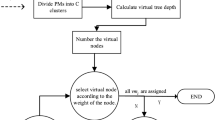Abstract
Virtualization is the essence of cloud computing. It facilitates the providers by virtualizing the storage, servers and other resources which aids in providing the computing services on shared and demand basis via internet. Virtual machine allocation is critical to achieving this goal, which accounts for effective resource usage with minimum expenditure. An efficient allocation results in effective resource utilization thus reducing wastage. This article proposes a genetic-based method exploiting the dual chromosome representation technique. The primary objective is to lessen the imbalance in resource utilization by reducing resource wastage. Another aim is to limit the power usage of the data center by diminishing the active servers’ volume. Lastly, the algorithm is evaluated against other existing work corresponding to several metrics which is further supported by the simulation procedure. The analysis from the result obtained displays a better performance of the algorithm by improving resource wastage, active server’s volume, CPU, and memory utilization.
Access this chapter
Tax calculation will be finalised at checkout
Purchases are for personal use only
Similar content being viewed by others
References
Beloglazov A, Buyya R (2010) Adaptive threshold-based approach for energy-efficient consolidation of virtual machines in cloud data centers. MGC@ Middleware 4(10.1145):1890799-803
Chaisiri S, Lee BS, Niyato D (2009) Optimal virtual machine placement across multiple cloud providers. In: Proceedings of IEEE Asia-Pacific services computing conference (APSCC). IEEE, pp 103–110
Adrian B, Heryawan L (2015) Analysis of K-means algorithm for VM allocation in cloud computing. In: International conference on data and software engineering (ICoDSE). IEEE, pp 48–53
Monil MA, Rahman RM (2016) VM consolidation approach based on heuristics, fuzzy logic, and migration control. J Cloud Comput 5(1):1–8
Moges FF, Abebe SL (2019) Energy-aware VM placement algorithms for the OpenStack neat consolidation framework. J Cloud Comput 8(1):1–4
Tang M, Pan S (2015) A hybrid genetic algorithm for the energy-efficient virtual machine placement problem in data centers. Neural Process Lett 41(2):211–221
Abdessamia F, Tai Y, Zhang WZ, Shafiq M (2017) An improved particle swarm optimization for energy-efficiency virtual machine placement. In: 2017 international conference on cloud computing research and innovation (ICCCRI). IEEE, pp 7–13
Shabeera TP, Kumar SM, Salam SM, Krishnan KM (2017) Optimizing VM allocation and data placement for data-intensive applications in cloud using ACO metaheuristic algorithm. Eng Sci Technol Int J 20(2):616–628
Gupta MK, Jain A, Amgoth T (2018) Power and resource-aware virtual machine placement for IaaS cloud. Sustain Comput Inform Syst 1(19):52–60
Ibrahim A, Noshy M, Ali HA, Badawy M (2020) PAPSO: a power-aware VM placement technique based on particle swarm optimization. IEEE Access 8:81747–81764
Regaieg R, Koubaa M, Ales Z, Aguili T (2021) Multi-objective optimization for VM placement in homogeneous and heterogeneous cloud service provider data centers. Computing 103:1255–1279
Gohil BN, Gamit S, Patel DR (2021) Fair fit—a load balance aware VM placement algorithm in cloud data centers. In: Advances in communication and computational technology. Springer, Singapore, pp 437–451
Poon P, Carter J (1995) Genetic algorithm crossover operators for ordering applications. Comput Oper Res 22(1):135–147
Agrawal RB, Deb K, Agrawal R (1995) Simulated binary crossover for continuous search space. Complex Syst 9(2):115–148
Author information
Authors and Affiliations
Corresponding author
Editor information
Editors and Affiliations
Rights and permissions
Copyright information
© 2023 The Author(s), under exclusive license to Springer Nature Singapore Pte Ltd.
About this paper
Cite this paper
Srivastava, A., Kumar, N. (2023). Virtual Machine Allocation Using Genetic-Based Algorithm in Cloud Infrastructure. In: Rawat, S., Kumar, S., Kumar, P., Anguera, J. (eds) Proceedings of Second International Conference on Computational Electronics for Wireless Communications. Lecture Notes in Networks and Systems, vol 554. Springer, Singapore. https://doi.org/10.1007/978-981-19-6661-3_24
Download citation
DOI: https://doi.org/10.1007/978-981-19-6661-3_24
Published:
Publisher Name: Springer, Singapore
Print ISBN: 978-981-19-6660-6
Online ISBN: 978-981-19-6661-3
eBook Packages: EngineeringEngineering (R0)




